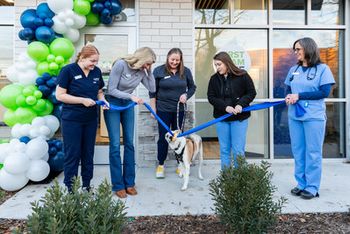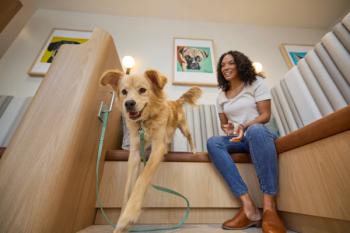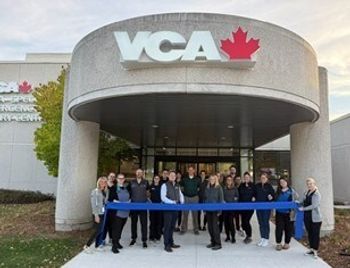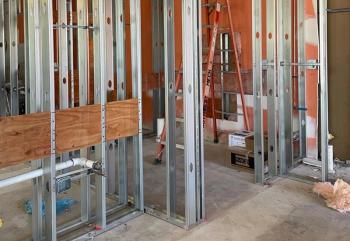
Highway inspiration
Drs. Buddy Smith and Benet Sandell started their building project reluctantly. Although they had contemplated renovating or rebuilding before relocating, a big push from a road project forced Hill Country Veterinary Hospital to build on a new site on the outskirts of Austin, Texas, 1/2-mile from their previous site. Today they practice in a 3,100-square-foot, award-winning facility.
By Carolyn Chapman,
special assignments editor
Drs. Buddy Smith and Benet Sandell started their building project reluctantly. Although they had contemplated renovating or rebuilding before relocating, a big push from a road project forced Hill Country Veterinary Hospital to build on a new site on the outskirts of Austin, Texas, 1/2-mile from their previous site. Today they practice in a 3,100-square-foot, award-winning facility.
The 2002 Veterinary Economics Hospital Design Competition judges bestowed a Merit Award on Hill Country Veterinary Hospital and named the practice the 2002 Best Small Hospital, a category reserved for hospitals 3,500 square feet or smaller. The judges praised the clean floor plan and beautiful exterior. "This floor plan has a great traffic flow," one judge extolled. "The combined business office and filing area off the reception counter works well in this plan," remarked another.
Practicing perseverance
Dr. Smith took over this practice 15 years ago and worked on building a client base. In 1992, Dr. Sandell joined the practice, and in 2000, she purchased the practice from Dr. Smith, who is her father-in-law. A year later she bought the building and property, which she financed through Dr. Smith and a local bank.
For two years the duo had heard rumors that a highway expansion would demolish their existing hospital site, but they needed state confirmation before they could pursue new property. "We needed the state buyout money to secure a new site," Dr. Smith says. The state stonewalled them for two years, then gave the practice only three months to vacate the building.
Wanting to remain in the same practice area, Dr. Smith scouted existing buildings, but found nothing suitable. He finally settled on a long, narrow half-acre lot a half-mile away. "Realistically, it was our only option," Dr. Smith says.
An attorney specializing in relocations helped Dr. Smith negotiate the buyout with the state transportation office. "I didn't know we could be reimbursed for moving our sign and hooking up our utilities," he says. They settled the price for the old facility in court. "Unfortunately, the state paid us fair market value based on a warehouse value, not a veterinary hospital," Dr. Smith says.
The owners met other frustrations as they worked to develop their new property. For example, the city required an additional 30-foot frontage setback for a future Right-of-Way easement and a sizable retention pond at the front of the site. As a result, the hospital sits 100 feet back from the road, which reduced kennel space at the back. A roadside sign helps draw attention to the hospital.
For a year during construction, the doctors practiced out of a trailer at the front of the site, and the state paid for the lease. "We were cramped, but the trailer was our best option," Dr. Sandell says.
Wary builders
Drs. Sandell and Smith admit they entered this project reluctantly. Before the road proposal came through, they were prepared to remodel their old facility. But when news circulated concerning the road project, Dr. Smith approached Ralph Thibodeau, an architect in Austin who designs veterinary facilities, about designing a new hospital. After purchasing the land, they gave Thibodeau rough sketches, which he translated into a workable floor plan. "He did an excellent job using every square inch of space," Dr. Sandell says.
Dr. Smith wanted the new facility to include separate waiting areas for dogs and cats, attractive retail displays, a central reception desk, open space for visual monitoring, and natural light throughout. "The final plan is an outgrowth of our practice philosophy," says Dr. Sandell. "It fits the way we practice."
Thibodeau says the tiny site proved to be his biggest challenge. "We really maxed out that site," he says. "I know the owners would have liked more dog runs, but there just wasn't any more room."Thibodeau specified durable and maintenance-free materials throughout the clinic. For example, Dr. Smith says a Formica-like covering on the kennel walls and the stained concrete floor are easy to maintain. "We originally had an epoxy painted floor in the utility and kennel areas, and it kept chipping," says Dr. Smith. "We weren't happy with the outcome until we sandblasted them and started over with acid-stained concrete."
To blend with surrounding buildings, the doctors chose a native limestone and stucco exterior. The roof is a combination of galvanized steel and composition shingle, and the oak trees give the new structure a feeling of permanence.
Inside, a central reception desk divides the cat and dog waiting areas. Filing cabinets lie hidden in alcoves behind the desk, keeping them handy for staff members yet invisible to clients. Two doors in the dog waiting area lead to the dog exam rooms, while the single cat exam room sits off the cat waiting area. A short hallway leads from the dog exam rooms to the pharmacy; the cat exam room leads to the lab and isolation areas. "We positioned isolation up front so we don't have to take those animals through the treatment area," Dr. Sandell says. Two lift tables, one in an exam room and one in the treatment area, accommodate the numerous large dogs the veterinary hospital treats.
An employee lounge near the treatment area facilitates internal communication and features shelves and lockers for each team member. Bar seating provides an adequate break space but doesn't encourage too much lingering. Clustered at the back, the surgery, scrub, and pack/prep areas sit near ICU and the treatment area.
In the boarding area, Dr. Sandell says the cinderblock runs with aluminum gates have proven durable and easy to maintain. To reduce noise, acoustic panels were used on the ceiling, and a Plexiglas top seals the runs without making dogs feel trapped. Glass block windows allow natural sunlight to shine in.
Boosting business
Much to the doctors' surprise, business grew 20 percent while they were operating in the modular unit. "It was noisy and cold in the unit, but the practice was very visible to several new communities in the area," Dr. Sandell says.
And practicing on the building site permitted the veterinarians to visit the project several times each day. Fortunately, they caught just a few minor mistakes during building. For example, the flushing drain wasn't in the correct position and the gas evacuation system was mounted on the outside of the wall instead of the inside of the wall.
In hindsight, Drs. Sandell and Smith wish they could have found a larger site to build on. Dr. Sandell hopes to purchase the adjacent lot to expand the kennels and the surgery suite. And for those of you who expect a future relocation, Dr. Smith advises hiring a lawyer so you have someone looking out for your best interests.
Dr. Sandell and her associate Dr. Cammie Teliha expect to work in the new building for years, and Dr. Smith, who still works at the practice part time, is able to enjoy the fruits of his hard work. All three are pleased with their new facility. "The efficient flow of the practice makes it easier to complete projects," says Dr. Sandell. "The new building lifts everyone's spirits."
Carolyn Chapman, a former Veterinary Economics associate editor, is a freelance writer in Liberty, Mo.
Newsletter
From exam room tips to practice management insights, get trusted veterinary news delivered straight to your inbox—subscribe to dvm360.





